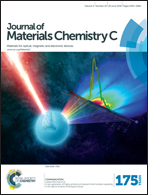A thermoresponsive fluorescent rotor based on a hinged naphthalimide for a viscometer and a viscosity-related thermometer†
Abstract
A new fluorescent smart unit (BNAP) based on bisnaphthalimide was designed and synthesized, in which two naphthalimide segments were conjugated through a twisted single bond at the 4-site. With the dual naphthalimide planes, BNAP can act as a double-channel rotor, which can output the shorter emission in the twisted state and the longer emission in the planar state. Because of the restriction of intramolecular rotation (RIR) effects, BNAP showed strong emission character in high viscosity circumstances. The longer and moderate emission in aggregates is attributed to the synergetic effects of RIR and intramolecular planarization. As a molecular rotor with dramatic changes in both emission wavelength and intensity, BNAP could be developed for the rapid detection of viscosity. The probe generates a logarithmic response to the viscosity of a glycerol/water system with different ratios. Furthermore, the probe exhibits high sensitivity to viscosity-related temperature variations. This property is very important because temperature always changes the surrounding viscosity in many biological systems and mechanical systems.


 Please wait while we load your content...
Please wait while we load your content...